America’s New Boom Towns: Can These Cities Handle the Moving Surge?
Welcome to America’s new boom towns – cities across the U.S that are estimated to experience unparalleled growth by the year 2100. From Dallas, Texas to the Miami metro area, these cities have seen influxes of people looking to call these boom towns home. But with this explosion in population comes several potential problems. Problems such as:
- Extended suburban sprawl
- Overloaded schools and hospitals
- Huge increases in cars on the road
Can these cities handle all this growth without any hiccups?
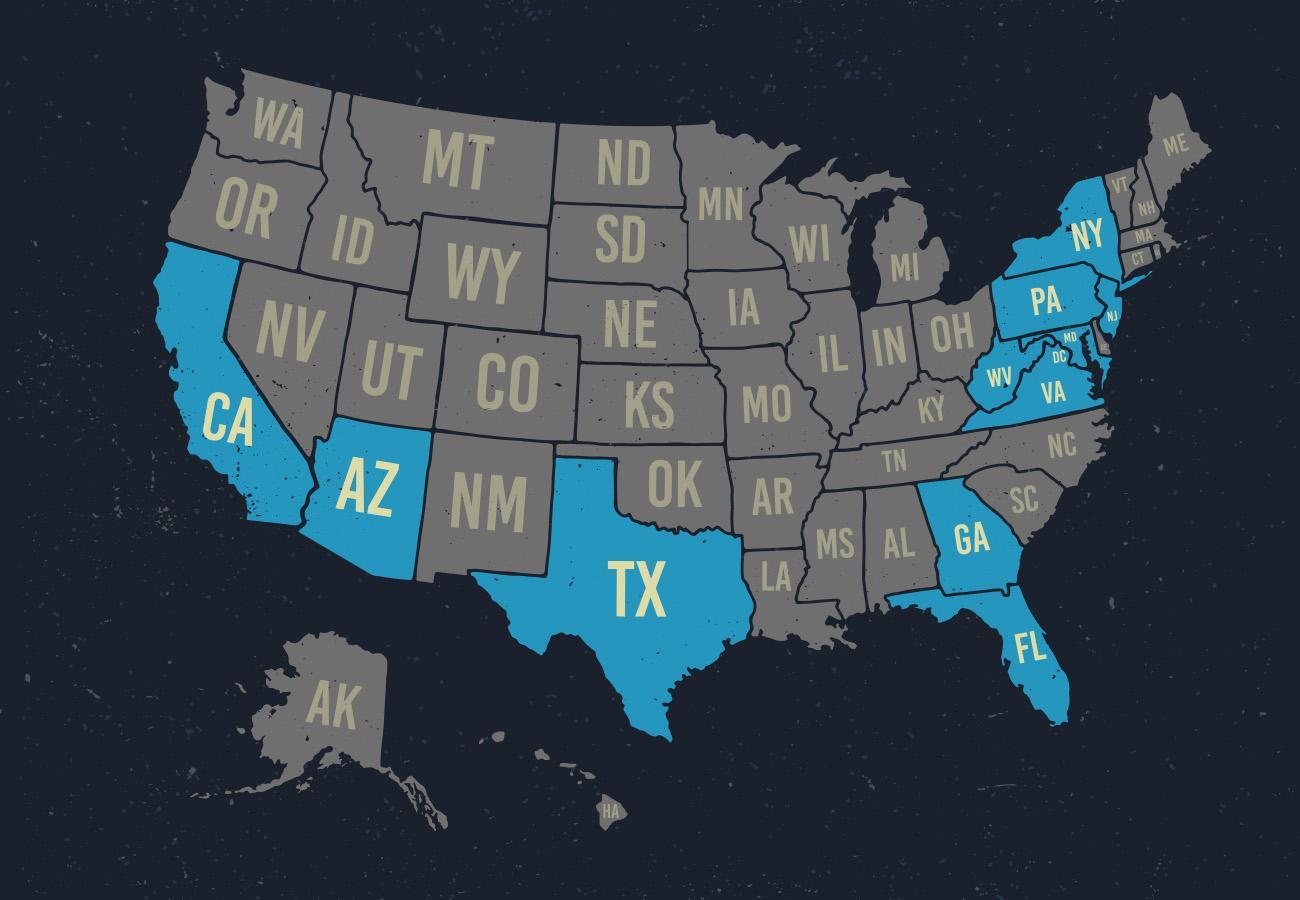
Based on current migration trends, moveBuddha predicted that by the year 2100, Dallas, Houston, and Austin will replace NYC, LA, and Chicago as the country’s most populous cities. moveBuddha then analyzed the statistics behind these recent population surges in American metropolitan areas and applied the data to everyday life to see what it would actually look like in the year 2100 if the population boom keeps growing at today’s rate.
moveBuddha researched these specific factors that would impact American home movers and the people currently residing in these metropolitan areas: number of schools, hospital beds, drivers on the road and the number of households needed to be built. These were chosen because they are key quality-of-life factors that every home mover should consider before choosing a new place to call home.
Moving is no small task, especially when moving across the country. We analyzed the cities that are projected to have huge population growth in the next 77 years to find what that actually means in terms of urban sprawl, the local hospitals, the number of houses needed, the local school system, and the number of drivers that will be on the road. With over 400,000 people using the moveBuddha website to plan their moves each year, we have deep insight into the most popular places people are moving to and from.
The Dallas-Fort Worth Metroplex
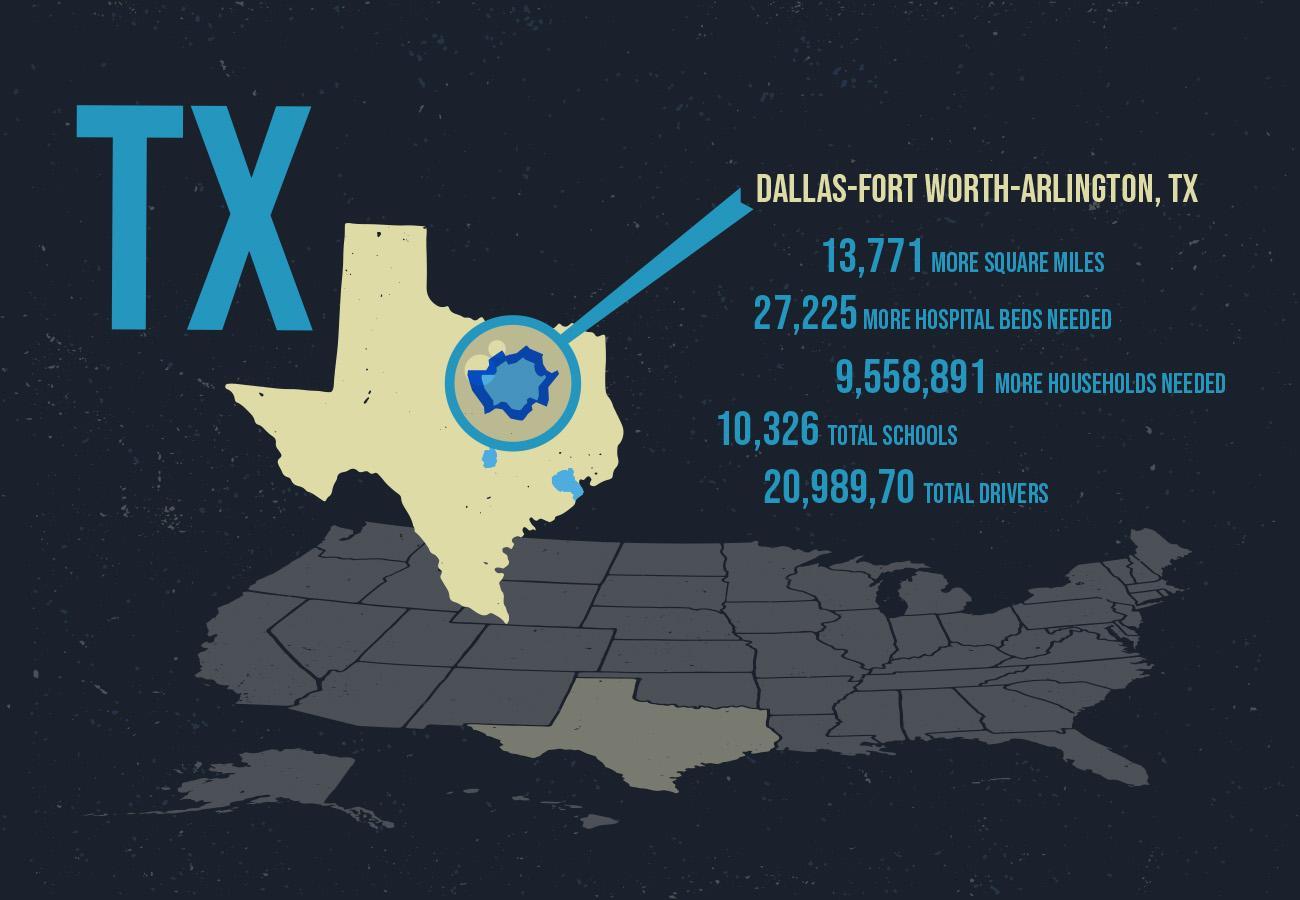
In the year 2100, there will be 20,989,708 drivers in the Dallas Metroplex area; that’s more than the number of people living in the entire state of Texas in 2021 (18.2 million).
3,771 more square miles of the Metroplex area will be needed to keep the population density the same as in 2021.
27,225 more hospital beds will be needed to keep the same number of hospital beds per person as in 2021.
9,558,891 more households are needed in the Metroplex area to accommodate the new population at the same people-to-household ratio.
10,326 total schools are needed in the Metroplex area to accommodate school-aged children at the same school-to-student ratio.
Houston-The Woodlands-Sugar Land, TX
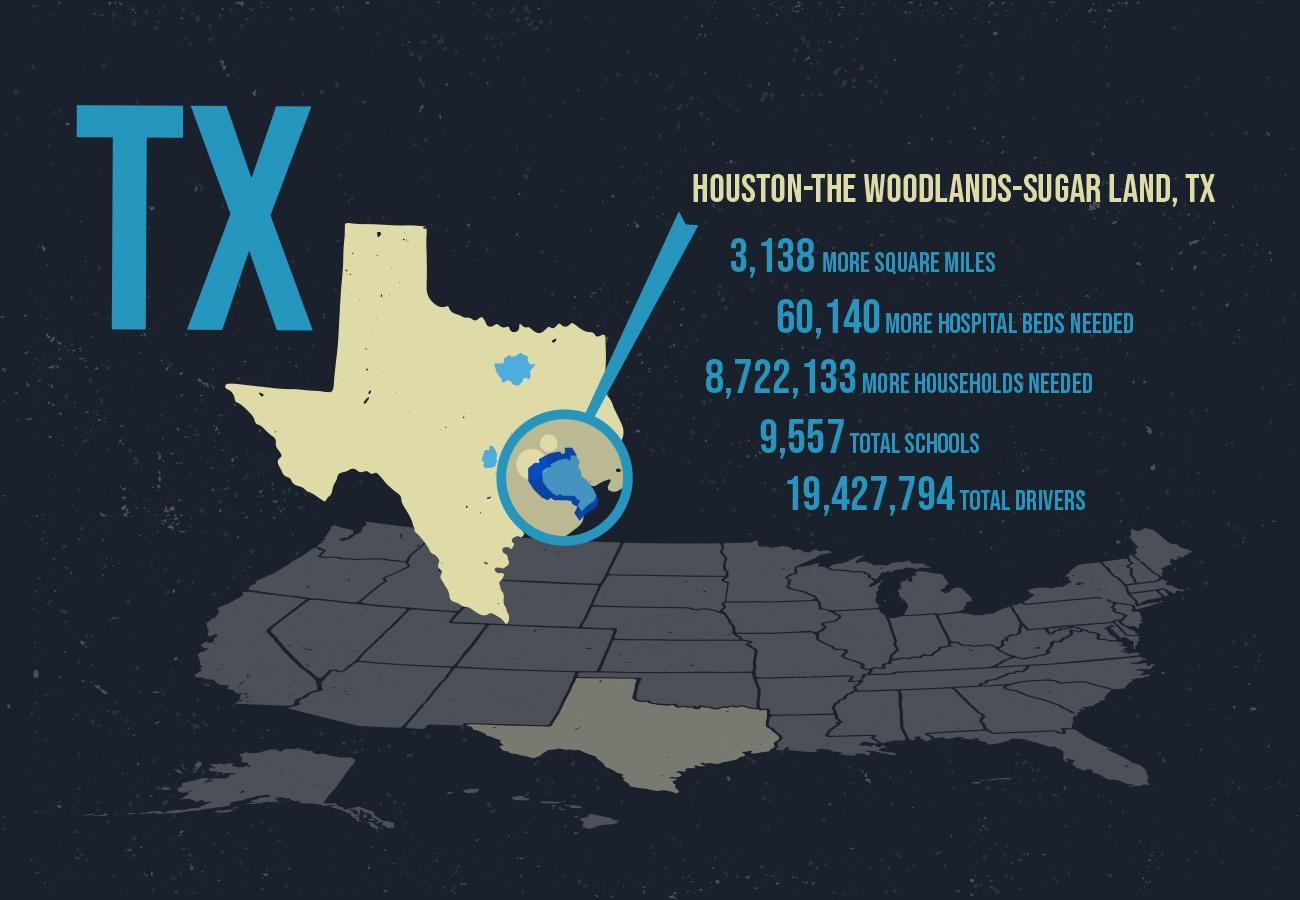
In the year 2100, the Greater Houston area will need approximately 329 more hospitals to accommodate the population at the current beds-per-hospital rate.
3,138 more square miles will be needed to keep the population density the same as in 2021.
8,722,133 more households will be needed in the Greater Houston area to accommodate the new population at the same people-to-household ratio.
9,557 total schools are needed in the Greater Houston area to accommodate school-aged children at the same school-to-student ratio.
19,427,794 total drivers will be on the roads, which is more than the 2021 population of the Greater Houston area.
Related: Best Moving Companies in Texas
Austin-Round Rock-Georgetown, TX
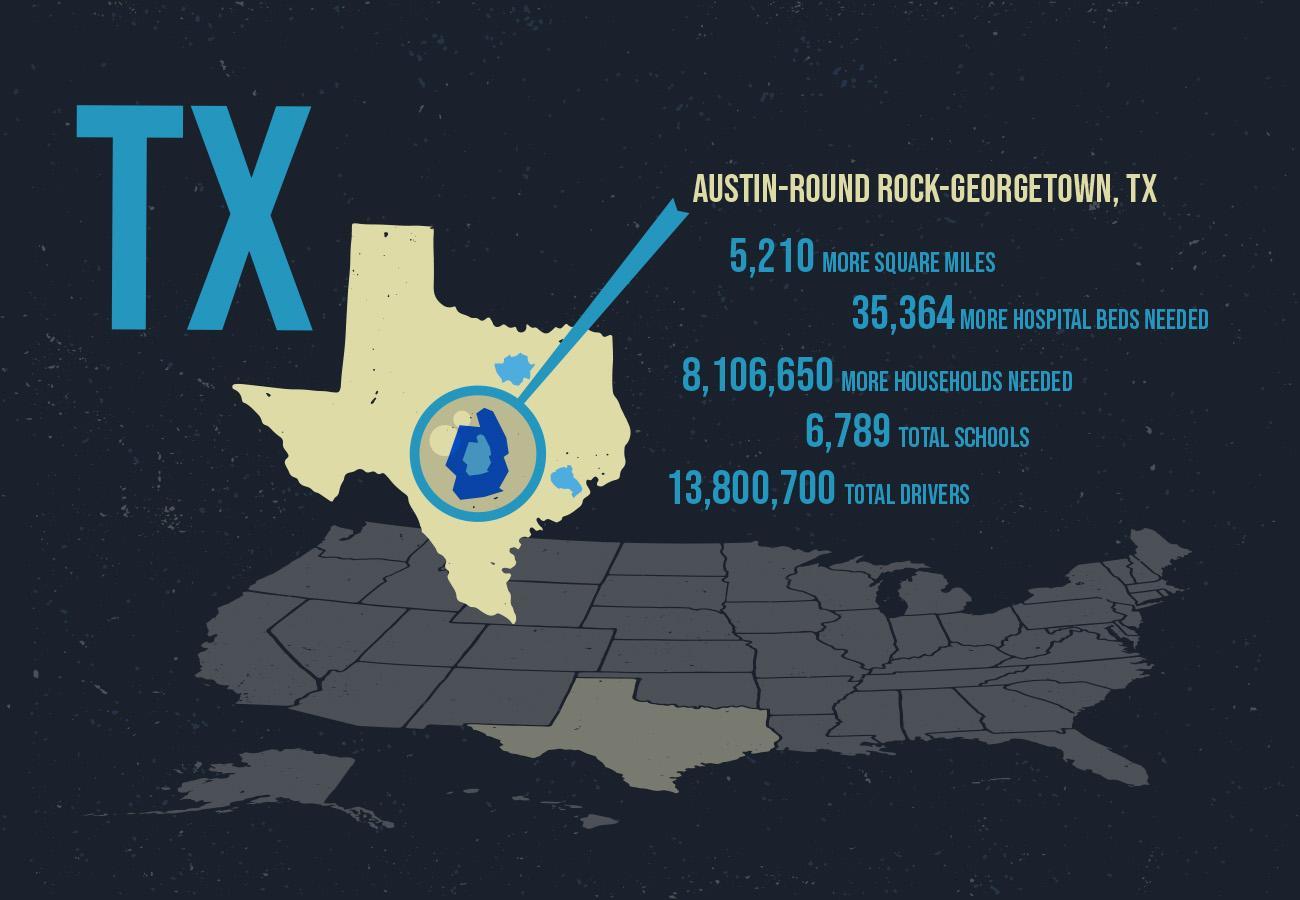
The Greater Austin area will have to grow by another 5,210 square miles in order to accommodate the growth of the city to the year 2100, stretching it to the following counties: Burnet County (1,021 square miles), Blanco County (714 square miles), Bastrop County (896 square miles), Lee County (634 square miles), Guadalupe County (715 square miles), and Bexar County (1,256 square miles).
The Greater Austin area will need 35,364 more hospital beds to accommodate the new population.
8,106,650 more households will be needed in the Greater Austin area to keep the same people-to-household ratio.
6,789 total schools will be needed in the Greater Austin area.
13,800,700 total drivers will be on the roads of Greater Austin by the year 2100 if the driver-to-population ratio stays as it was in 2021.
Phoenix-Mesa-Chandler, AZ
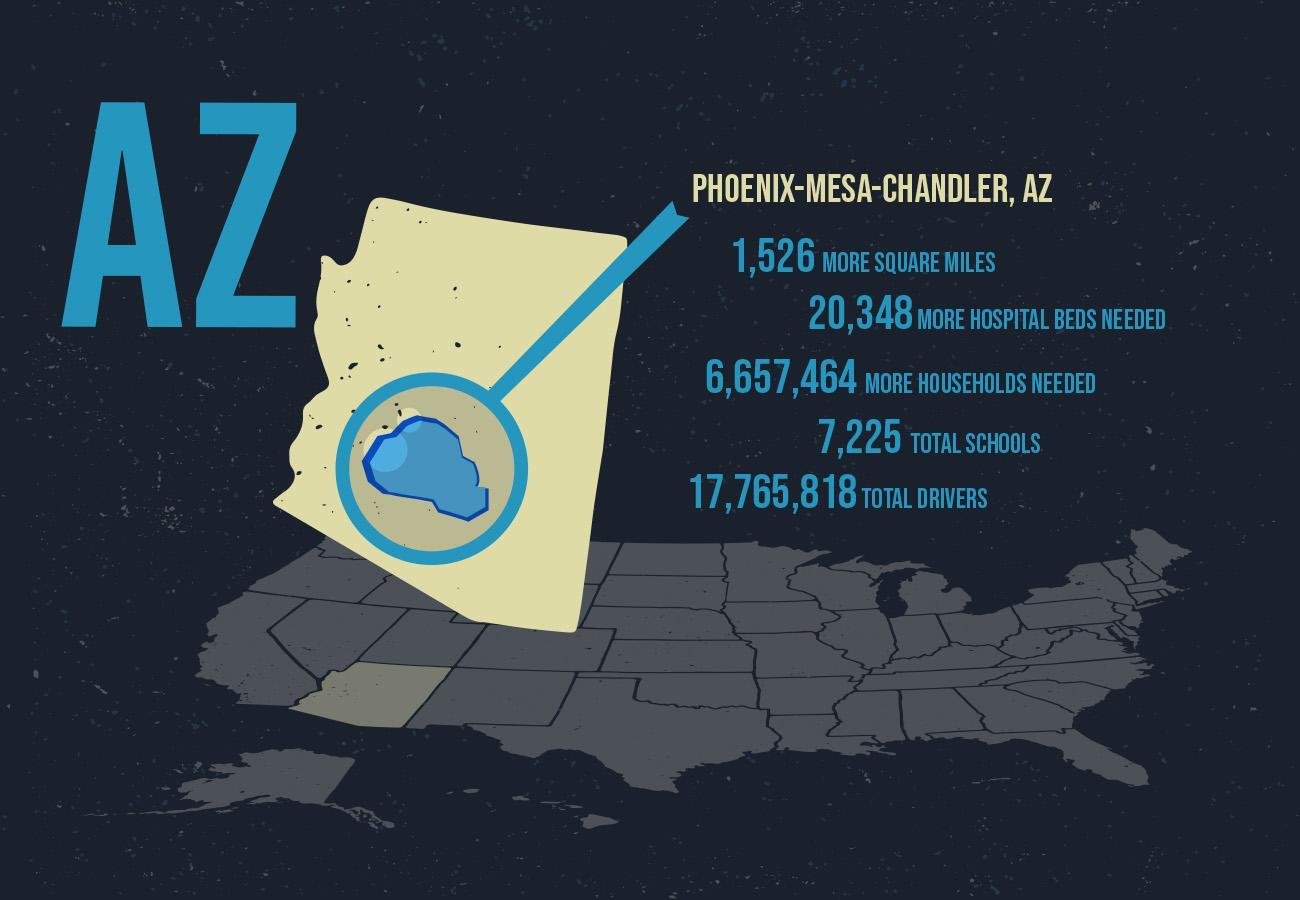
The Phoenix metropolitan area will need 6,657,464 more households to accommodate the 2100 population to keep the same people-to-household ratio as it was in 2021. Compare that to the fact that there were 1,863,195 households in the area in total in 2021.
1,526 more square miles will be needed in the Phoenix metropolitan area in order to accommodate the growth of the city to the year 2100.
20,348 more hospital beds will be needed to accommodate the new population.
7,225 total schools accommodate the new population.
17,765,818 total drivers will be on the road in the Phoenix metropolitan area in the year 2100.
Related: Best Moving Companies in Arizona
New York-Newark-Jersey City, NY-NJ-PA
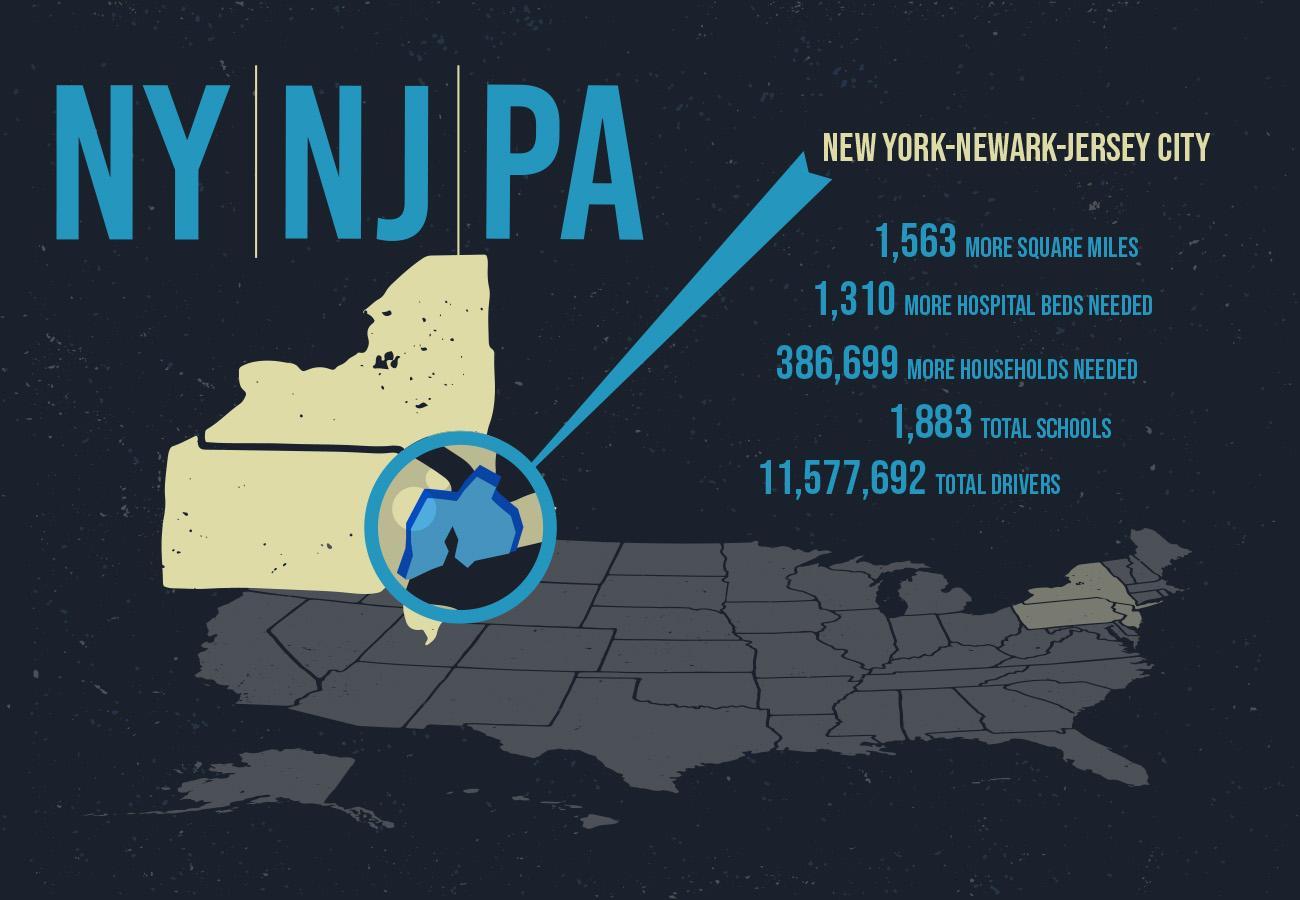
The New York metropolitan area will need another 1,563 square miles to accommodate the 2100 population to keep the same population density as it was in 2021.
1,310 more hospital beds will be needed to accommodate the new population in the Tri-State area.
386,699 more households will be needed to accommodate the new population.
1,883 total schools will be needed to keep the same school-to-student ratio.
11,577,692 total drivers will be on the road in 2100 if the 2021 rate of drivers-to-population continues.
Atlanta-Sandy Springs-Alpharetta, GA
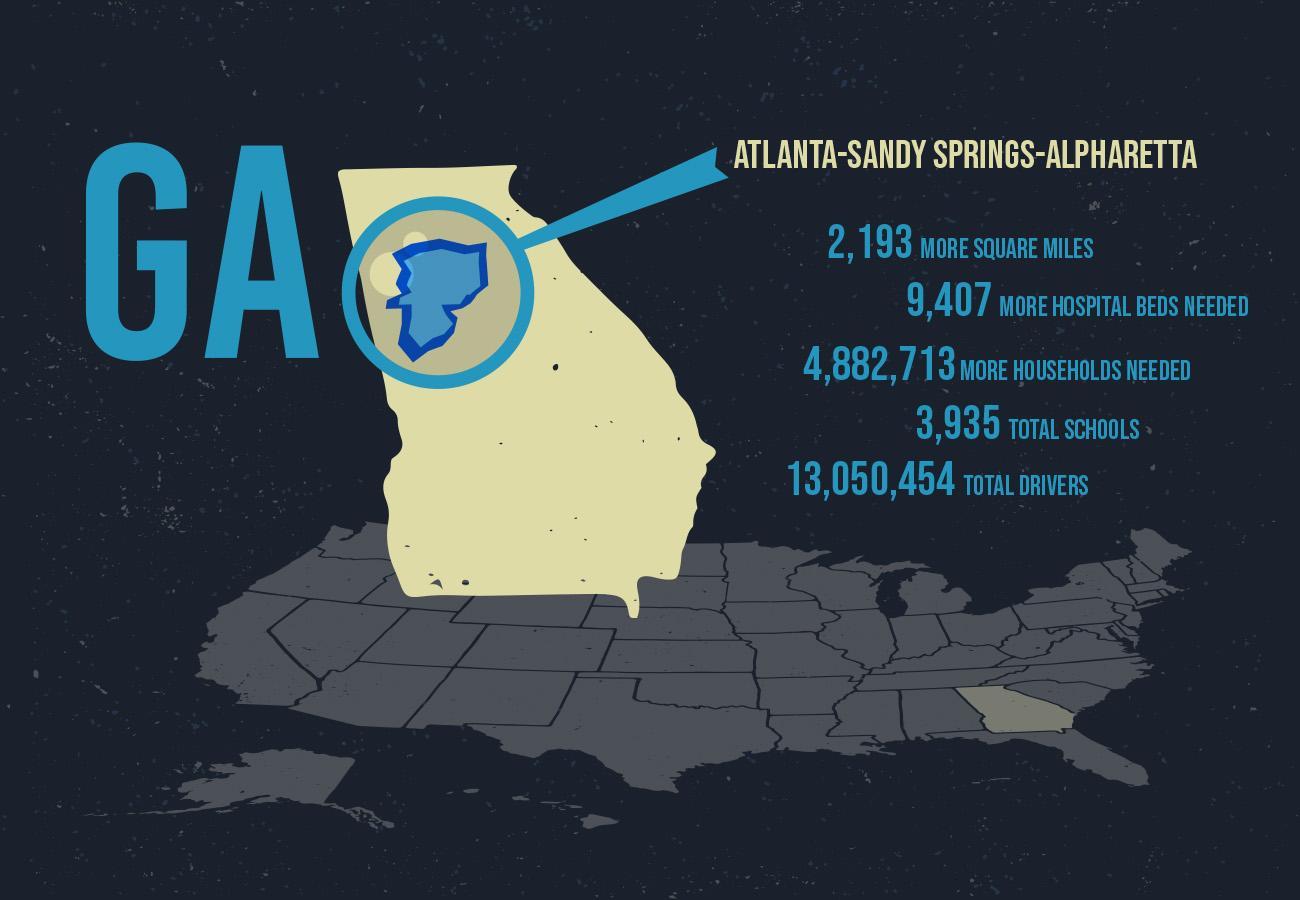
Metro Atlanta will need 2,193 more square miles to accommodate the 2100 population. That stretches the metro area to include the following counties: Putnam County (361 square miles); Greene County (406 square miles); Wilkes County (474 square miles); Taliaferro County (195 square miles); Elbert County (374 square miles); Banks County (234 square miles); and part of Franklin County (266 square miles).
9,407 more hospital beds will be needed to accommodate the new population in the Atlanta metropolitan area.
4,882,713 more households will be needed to accommodate the new population.
3,935 total schools will be needed to keep the same school-to-student ratio.
13,050,454 total drivers will be on the road in 2100 if the 2021 rate of drivers-to-population continues.
Related: Best Moving Companies in Georgia
Los Angeles-Long Beach-Anaheim, CA
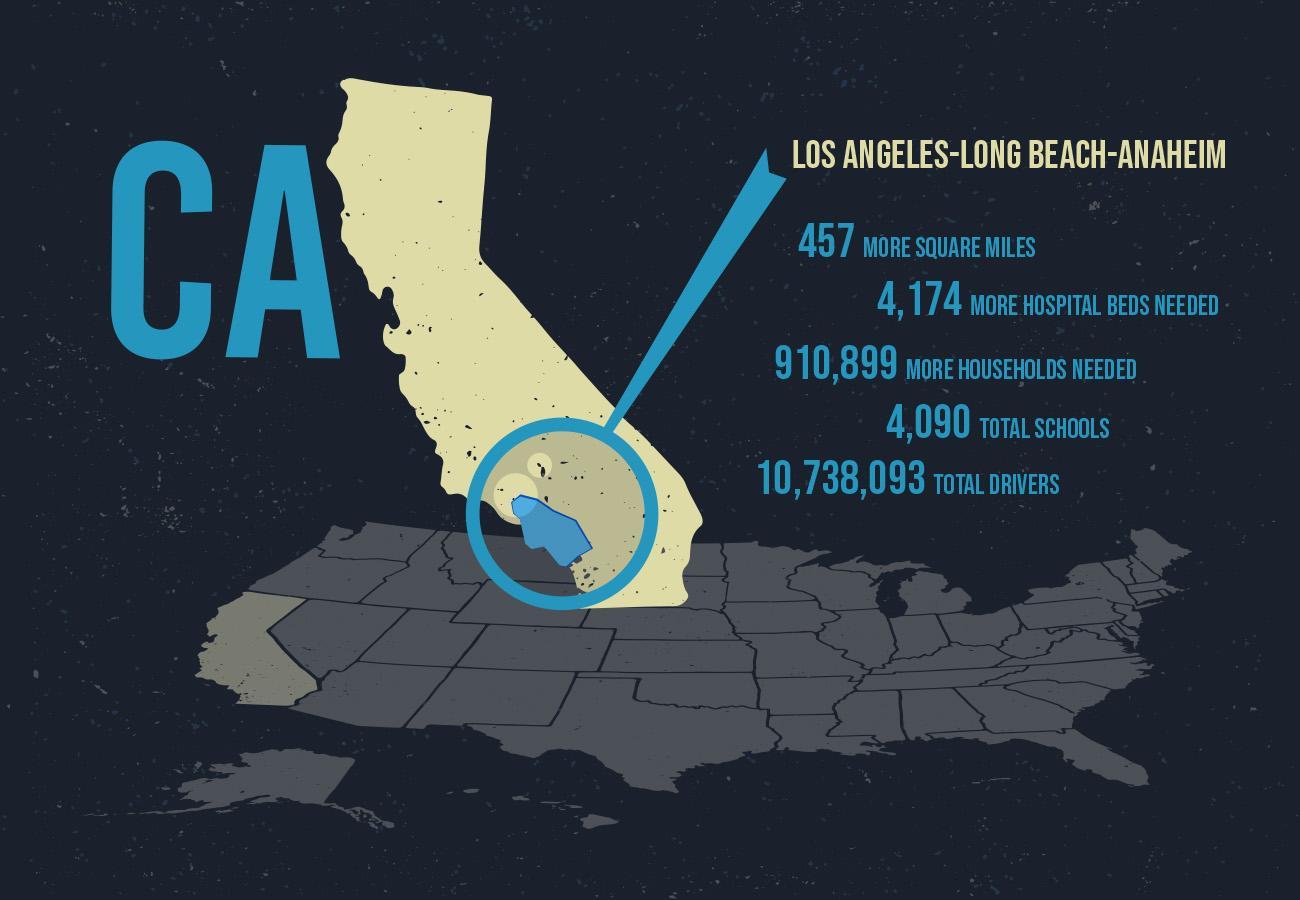
The Greater Los Angeles area will need 4,090 more schools by the year 2100 to accommodate the population at the current people-per-school ratio.
457 more square miles will be needed to accommodate the 2100 population.
4,174 more hospital beds will be needed to accommodate the new population in the L.A. metropolitan area.
910,899 more households will be needed to accommodate the new population.
4,090 total schools will be needed to keep the same school-to-student ratio.
10,738,093 total drivers will be on the road in 2100 if the 2021 rate of drivers-to-population continues.
Related: Best Moving Companies in California
Washington-Arlington-Alexandria, DC-VA-MD-WV
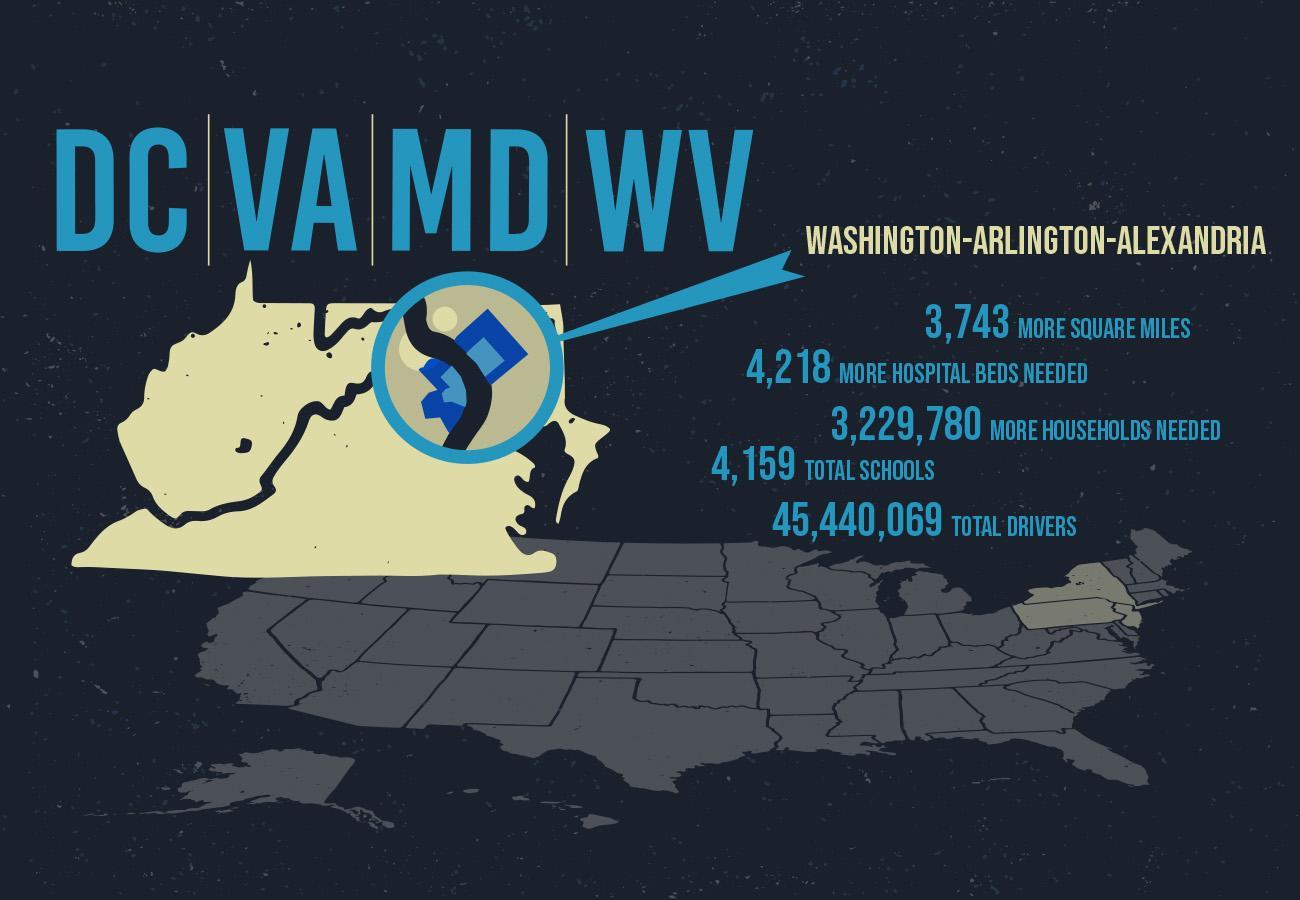
The National Capital Region will have to nearly double in size to accommodate the 2100 population. In fact, 3,743 more square miles will be needed to accommodate the 2100 population (making it 1.94 times larger).
4,218 more hospital beds will be needed in the Washington metropolitan area to accommodate the new population at the 2021 ratio.
3,229,780 more households will be needed to accommodate the new population.
4,159 total schools will be needed to keep the same school-to-student ratio.
45,440,069 total drivers will be on the road in 2100 if the 2021 rate of drivers-to-population continues in the area.
Orlando-Kissimmee-Sanford, FL
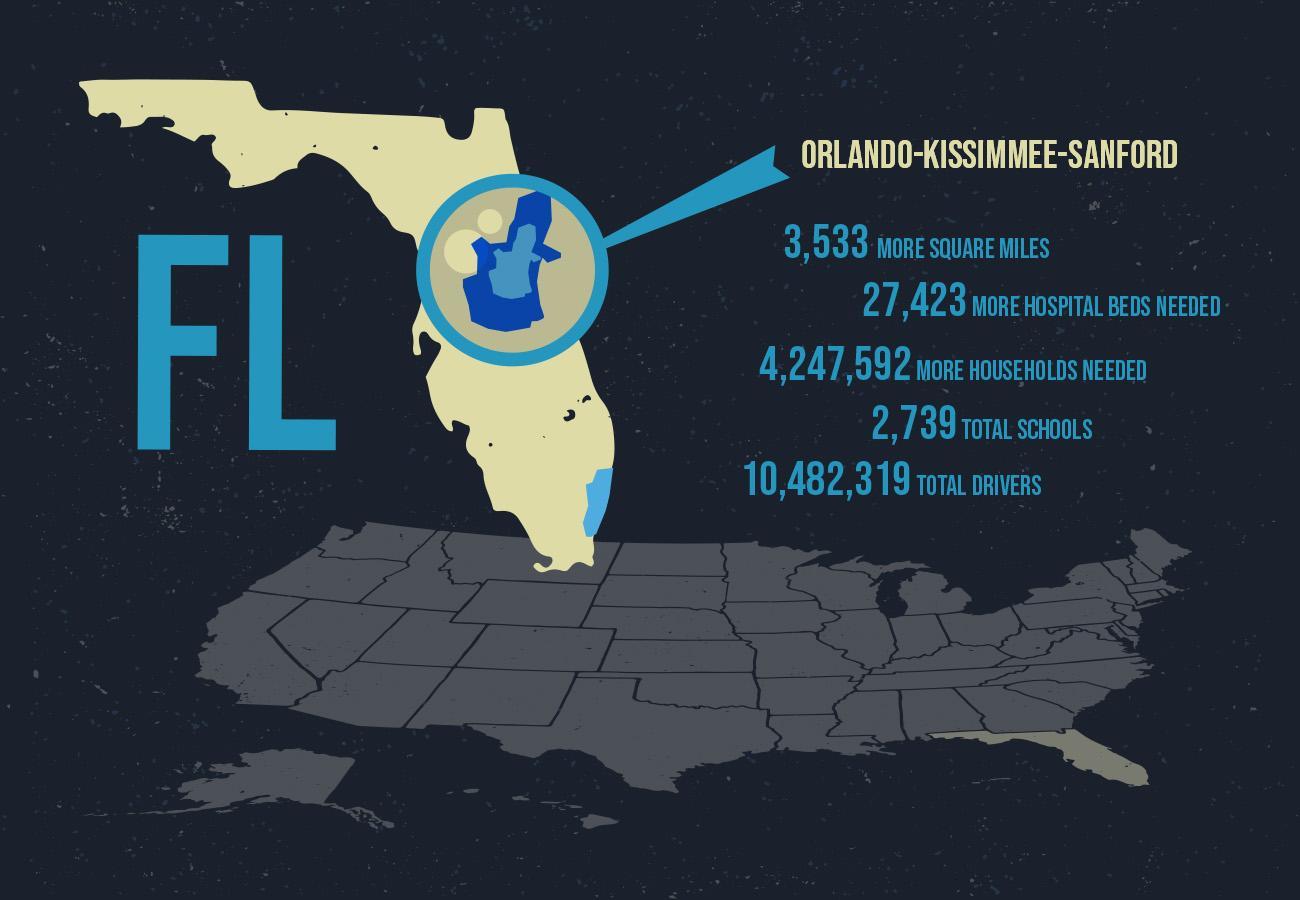
The Orlando metro area will have to grow by another 3,533 square miles in order to accommodate the growth of the city to the year 2100. This stretches the greater Orlando area to Polk County (1,798 square miles) and Brevard County (1,557 square miles).
27,423 more hospital beds will be needed in Metro Orlando to accommodate the new population based on beds-per-person 2021 ratios.
4,247,592 more households will be needed to accommodate the 2100 population.
2,739 total schools will be needed to keep the same school-to-student ratio.
10,482,319 total drivers will be on the road in 2100 if the 2021 rate of drivers per population continues in the area.
Related: Best Moving Companies in Florida
Miami-Fort Lauderdale-Pompano Beach, FL
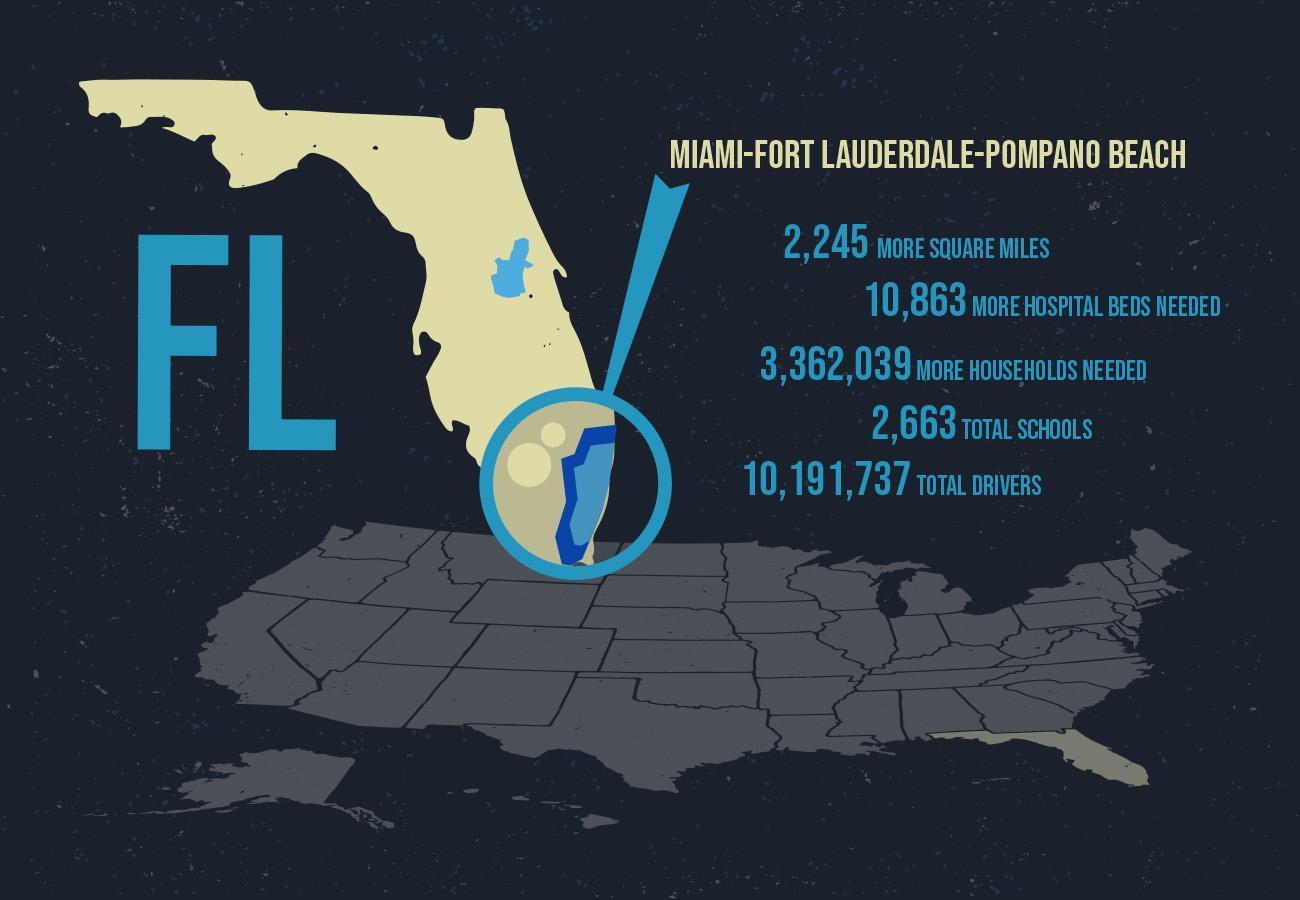
The Miami metropolitan area will need more than double the number of houses it currently has in order to accommodate its estimated 2100 population. According to 2021 Census data, the metro area had 2,662,580 households in 2021. If the area continues to grow at the same rate, 3,362,039 more households will be needed by the year 2100.
2,245 more square miles will need to be added to the Miami metropolitan area to hold the 2100 population at the same people per square mile ratio of 2021.
10,863 more hospital beds will be needed to accommodate the new population.
2,663 total schools will be needed to keep the same school-to-student ratio.
10,191,737 total Gold Coast drivers will be on the road in 2100 if the 2021 rate of drivers by population continues.
Sources and Methodology
This report uses data sourced from the U.S. Census Bureau. We wanted to know at moveBuddha what U.S. metropolitan areas would see the biggest population growth by 2100. We did this by using the compound annual population growth rate of the biggest U.S. metro areas (250,000 residents or more) between the 2010 and 2020 U.S. Census estimates and extrapolating it over 80 years.
This was an inexact science, and growth rates are bound to change. But it gave us a rough idea of which American cities may rise to the top by the dawning of the 22nd century. Climate change effects, migration patterns from climate change, and other unforeseen events could change things.
Unless otherwise indicated, city-specific data was sourced from:
- Texas Association of Counties’ County Information Program
- The American Hospital Directory
- CensusReporter.org
- National Center for Education Statistics
- Federal Highway Administration
- For city-specific data and methodology view the full dataset here.
Not what you were looking for?
Check out other categories that can help you find the information you need!

